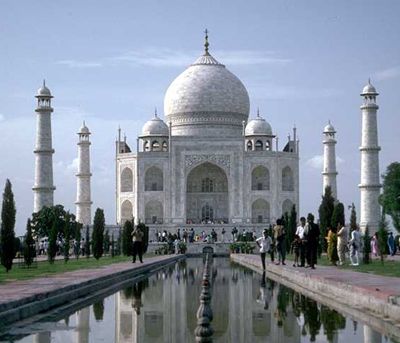


The Golden Temple or Darbar Sahib, situated in Amritsar, Punjab, is the most sacred temple for Sikhs. It is a symbol of the magnificence and strength of the Sikh people all over the world. In the evolution of the Darbar Sahib, is entwined the history and ideology of Sikhism. In its architecture are included, symbols associated with other places of worship. This is an example of the spirit of tolerance and acceptance that the Sikh philosophy propounds.
The history of the Darbar Sahib starts with Guru Amar Das, who took the first steps towards building a shrine. Around the Golden Temple, the holy city of Amritsar came into being. His successor, Guru Ram Das, came to live near this tranquil and peaceful site, and started building the pilgrimage centre around the small pool, (later to become the Sarowar) which had intially drawn Guru Amar Das.
By the time of Guru Ram Das' death, the pre eminence of the Darbar Sahib among the sikh devotees was unquestionable.
The Harmandir Sahib, or the sanctum sanctorium, was envisoned by Guru Arjan Dev. This was concieved by him to reflect the resoluteness, clarity and simplicity of the Sikh relegion. The Harmindir Sahib today stands as the hallowed symbol of the indestructability of the Sikh faith. He designed it to have four doors, one on each side. The Golden Temple, would thus be open to all four castes-Kshatriyas, Brahmins, Sudras & Vaisyas.
The gilding, marble, mirror and inlay work on the Harmandir Sahib came much later. It was the nineteenth century during the reign of Maharaja Ranjit Singh, that the proud people of Punjab lavished their wealth on their shrine in Amritsar.
The Granth Sahib, the holy book of the Sikhs, was installed in the Harmandir Sahib in 1604, three years after its completion. The location of the Granth Sahib here, adds to the sanctity & reverence of the Harmandir Sahib. Here lies the heart of Sikhism. This symbol of abiding faith and tolerance is held in high esteem by every Sikh. And this is the place which every Sikh dreams, ever so often, of visiting.
In 1612, Arjumand Banu Begam, better known by her other name , Mumtaz Mahal was married to Shah Jehan (then Prince Khurram), the fifth mughal emperor. This marriage, although the emperor's second, was a real love-match, and Mumtaz was her husband's inseparable companion on all his journeys and military expeditions. She was his comrade, his counsellor, and inspired him to acts of charity and benevolence towards the weak and the needy. She bore him fourteen children, and died in childbed in 1630 (only three years after his accession to the throne) in Burhanpur in the Deccan where she had accompanied him on a military campaign.
Overpowered by grief, Shah Jehan was determined to perpetuate her memory for immortality and decided to build his beloved wife the finest sepulchre ever - a monument of eternal love. It was Shah Jehan's everlasting love for Mumtaz that led to the genesis of the Taj Mahal. The sad circumstances which attended the early death of the empress who had endeared herself to the people inspired all his subjects to join in the emperor's pious intentions. After twenty-two laborious years, and the combined effort of over twenty thousand workmen and master craftsmen, the complex was finally completed in 1648 on the banks on the river Yamuna in Agra, the capital of mughal monarchs.
The origin of the name the "Taj Mahal" is not clear. Court histories from Shah Jehan's reign only call it the rauza (tomb) of Mumtaz Mahal. It is generally believed that "Taj Mahal" (usually translated as either "Crown Palace" or "Crown of the Palace") is an abbreviated version of her name, Mumtaz Mahal (Exalted One of the Palace).
The Story of a Second Taj
According to popular legend, Shah Jehan decided to construct another Taj Mahal in black marble on the other side of the river Yamuna and to connect the two by a bridge. This structure was intended to be his own tomb. It has been recorded almost contemporarily by Tavernier : "Shah Jehan began to build his own tomb on the other side of the river but the war with his sons interrupted his plan and Aurangzeb who reigns at present is not disposed to complete it". Later gazetteers and guide books mention this story almost invariably. The irregular position of the cenotaph of Shah Jehan as compared to that of Mumtaz Mahal which occupies the exact centre of the hall is said to be proof of this assumption. The Mehtab Burj and the wall adjoining it opposite the Taj Mahal are generally said to be the foundations and remains of the proposed plan.
Many scholars, however, believe that this idea belongs to fiction rather than history. The traces which are identified as the foundations of the second Taj are actually the enclosing wall of a garden founded by Baber. The irregular position of Shah Jehan's cenotaph in comparison to Mumtaz Mahal's, is similar to that at the tomb of Itmad-ud-Daulah, and thus should not be of any striking significance. Besides, according to Islamic law, bodies are buried with their faces towards Mecca and legs towards the south, and the husband is placed on the right hand side of his wife. The interpretation that the cenotaph of Shah Jehan was not meant to be placed here appears to be superfluous.
